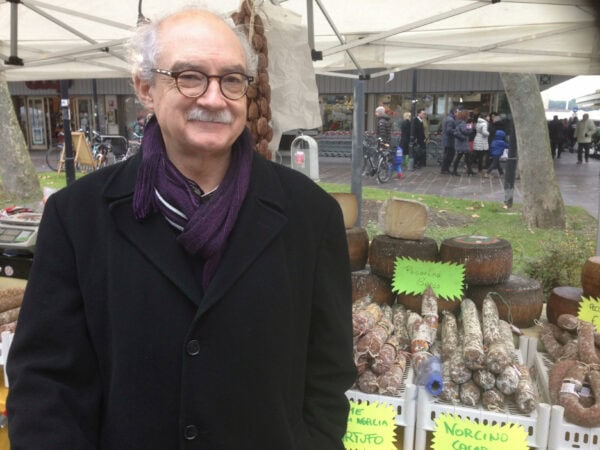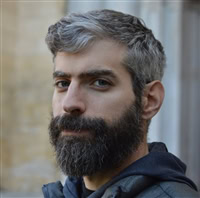On Saturday, January 7, 2023, Edward Muir, the Clarence L. Ver Steeg Professor in the Arts and Sciences, professor of history and Italian, and a Charles Deering McCormick Professor of Teaching Excellence at Northwestern University, becomes the 139th president of the American Historical Association. He begins his yearlong term during a period of considerable challenges for the AHA and the historical discipline. From divisive concepts legislation targeting both K–12 and higher education to undergraduate enrollments, from academic job availability to ongoing COVID-19 recovery efforts, a variety of important issues confront the Association as he begins his term.

AHA president Ed Muir enjoying an outdoor market in Italy. Courtesy Edward Muir
A scholar of Italian cultural and social history, Ed focuses on the history of ritual and violence during the later Middle Ages and into the 16th century. He has previously served as president of both the Sixteenth Century Society and Conference and the Renaissance Society of America. Among his many awards and fellowships, Ed has been a fellow at the Harvard University Center for Italian Renaissance Studies at Villa I Tatti, the Institute for Advanced Study, the National Humanities Center, the Center for Advanced Study in the Behavioral Sciences at Stanford University, and the Newberry Library. The author of multiple books and articles, his first book, Civic Ritual in Renaissance Venice (Princeton Univ. Press, 1981), won the AHA’s Herbert Baxter Adams Prize. His current project is tentatively titled The Delicate Sinews of Trust: The Italian Renaissance, 1350–1650. As a teacher, Ed offers undergraduate courses in Renaissance and Reformation history, with a freshman seminar on the great legal trials of Western history. He also teaches courses on microhistory, which he enjoys because it offers an opportunity to show students how to identify and explore marginal or minority figures, and modern Italian history, a subject that he loves simply because it is, in his words, “so weird.”
A fondness for weirdness may be what made Ed a historian in the first place. Born and raised in Utah, Ed had a fascination with history that shaped him from an early age. In third grade, he began reading about Paleolithic Switzerland and then Venice, discovering for the first time different cultures and new places beyond those he already knew. By the time he was in junior high in 1959, he was sure what his career would be—that year, when the Salt Lake City Tribune asked where he saw himself in the year 2000, he told the paper he would be a university history professor.
In addition to informing his general trajectory, Ed’s upbringing in the local religious community was formative for the particular course of his academic career. It was there, among the faithful recounting their visions as the Spirit moved them, that Ed first became suspicious of professions of belief. The Spirit would, he noticed, move the same people in the same way to say the same things time and time again. These professions of faith seemed to be more about behaving in a certain way in front of certain people than they were about the specific words said or their meaning. Ed observed that this ritual created the community he was part of, and that what was important was not what people said but what they did. Ed’s scholarly work has focused on such ritual acts rather than professed statements.
Despite these early interests, Ed’s path to becoming a professor and to the academic subject that has defined his career was not entirely straightforward. His father, he remembers, was not particularly fond of the idea of him becoming a history professor, preferring that his son follow his own long-abandoned ambitions and pursue a career in law. And although Ed did not have to struggle particularly hard to get his own way, his father never really understood his career choice. Even when Ed won the AHA’s prestigious Adams Prize, his father responded that it was still not too late to pursue law. Nevertheless, his father did get his way, after a fashion: the primary sources on which Ed’s work most relies are legal documents and case records.
Modern Italian history is a subject he loves simply because it is, in his words, “so weird.”
Ed did not start out as a cultural historian, nor did he arrive immediately at microhistory as his chosen methodology. He began his graduate study as an economic historian. Thanks in part to his childhood experiences with ritual and the questionable truth offered by statements of belief, Ed forsook histories of ideas and looked instead at histories of behaviors and actions. He was thus among the many historians of Italy trained in the 1960s and ’70s who began as quantitative historians of economic history before turning to cultural, qualitative study. Ed sees behavioralist history as an especially revealing approach, one that cuts across the social and economic divisions that usually confine historical study. Further, he is fascinated by the question of how to translate historical behaviors into something intelligible to modern readers, a question whose answer has strong ties to the history of emotions. It is therefore unsurprising that, when asked the standard Perspectives interview question of which three historians he would invite to dinner, he chose two cultural historians of early modern Europe, Natalie Zemon Davis and Christiane Klapisch-Zuber, and French medievalist Marc Bloch.
As with many premodernists, Ed’s teaching and research are temporally wide, but within his specialization, he finds the first two decades of the 16th century particularly fascinating. In his telling, they were a pivotal moment for change when “everything was up for grabs.” The papacy was suffering a legitimacy crisis, the legacy of the previous two centuries of institutional excess (he is not, for the record, a fan of Showtime’s The Borgias, despite the presence of the inestimable Jeremy Irons), and almost every kingdom, state, and principality was similarly in the midst of political turmoil. In this ferment, there was a “moment of soul-searching by articulate and well-educated people” struggling to find solutions. It was a moment that sparked the beginnings of modern political thought, and one that is all too relatable to the present day.
But what makes a good history for the AHA’s new president? Magisterial breadth of knowledge and exacting precision. Remembering what he still considers the pinnacle of the historian’s craft, Ed recounts a dinner party held at Princeton University sometime in the early 1980s, shortly after British historian Hugh Trevor-Roper incorrectly authenticated Konrad Kujau’s forged Hitler Diaries. Felix Gilbert, a historian of Europe who was part of the Office of Strategic Services during World War II and who had seen Hitler’s bunker with his own eyes, was in attendance. When the Diaries came up in conversation, Felix took over the room. In a straightforward, methodical manner and with no notes, he began a point-by-point demolition of the Diaries’ legitimacy. Forty years later, Ed still considers it the most stunning display of the historian and their art that he has ever seen.
His favorite activity is downhill skiing—snowboarding is for teens.
When not crafting his own meticulous scholarly works or teaching, Ed can be found in the wilderness. A self-described “mountain guy,” he loves to travel and hike. His favorite activity, however, is downhill skiing (snowboarding is for teens, he says). Although Ed is, by his own admission, getting a bit old for the sport, he considers dying of a heart attack midrun as the ideal way to go out. And while he doesn’t have a favorite ski slope, here too Ed displays a fondness for strangeness: the weirdest ski spots he’s ever been to are in the Swiss Alps. There, even at the swankiest resorts, the slopes are still old fashioned and lift service is spotty. Skiers often have to interrupt their run, take off their skis, and hike up the next ridge in order to get down the mountain. Though discordant to those used to the long, fast runs of the American West (or even the short, icy slopes of the Northeast), the older way of doing things has its own cadence and charm.
In the world of historical scholarship, however, Ed has an abiding enthusiasm for listening to new and exciting voices, which he credits as a means of keeping his own thoughts and interests fresh. Perspectives readers can look forward to reading the thoughts his conversations have inspired within these pages. He is particularly interested in highlighting historians engaged in fields that he believes have received inadequate attention in AHA events and publications. For, above all else, Ed sees the AHA presidency as an opportunity to amplify the voices of others.
This work is licensed under a Creative Commons Attribution-NonCommercial-NoDerivatives 4.0 International License. Attribution must provide author name, article title, Perspectives on History, date of publication, and a link to this page. This license applies only to the article, not to text or images used here by permission.

